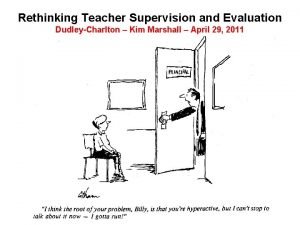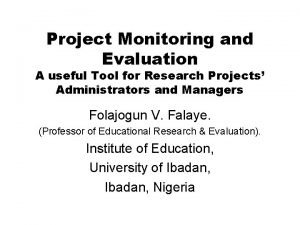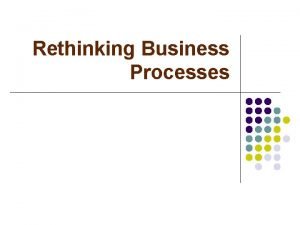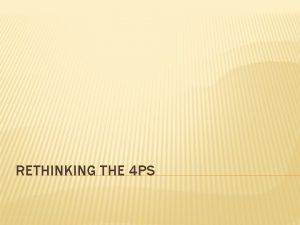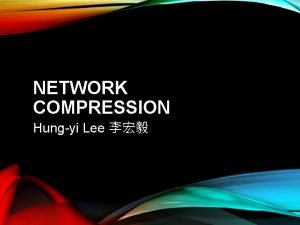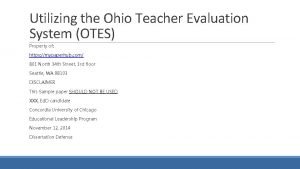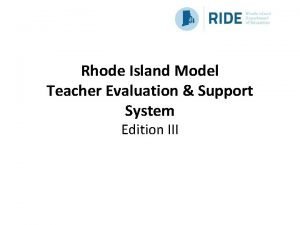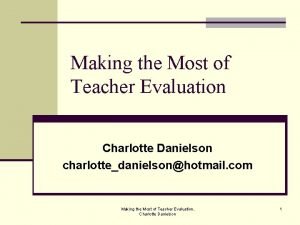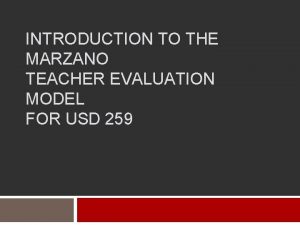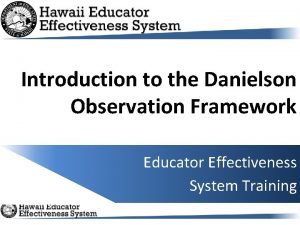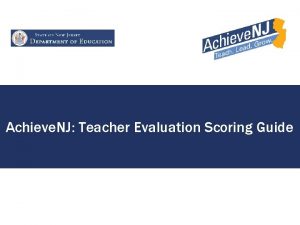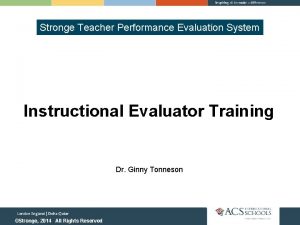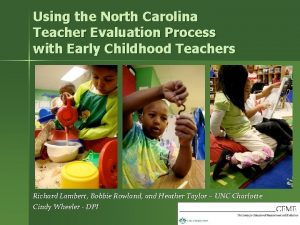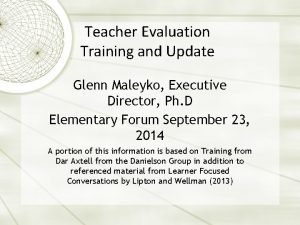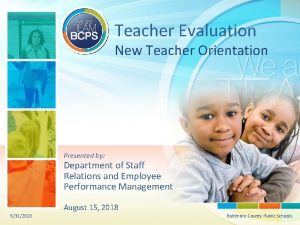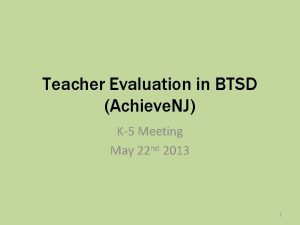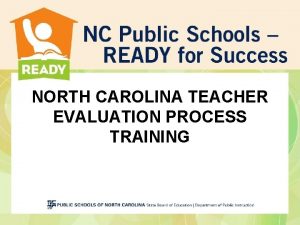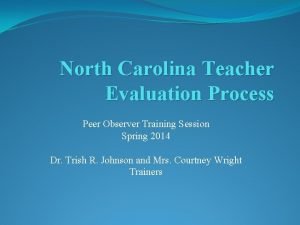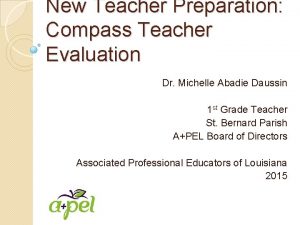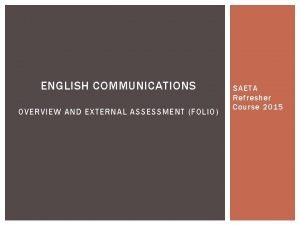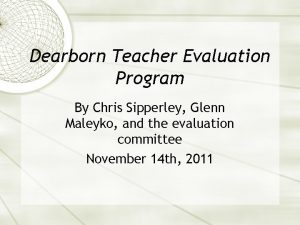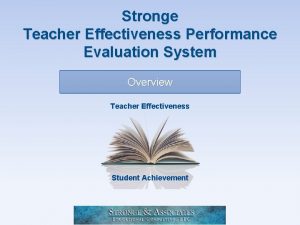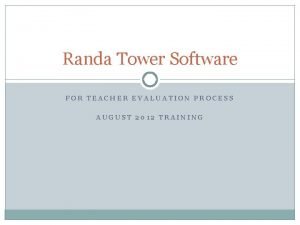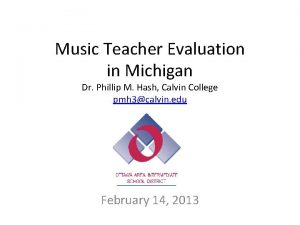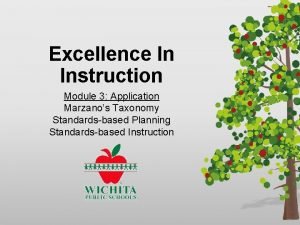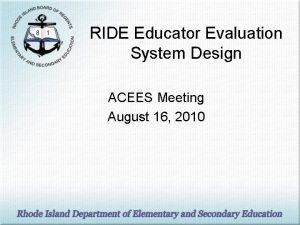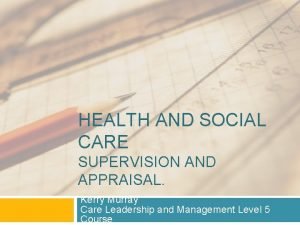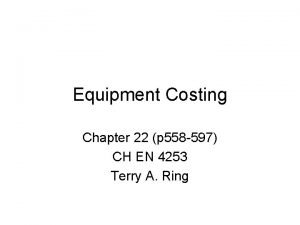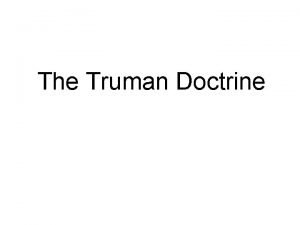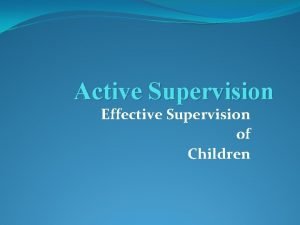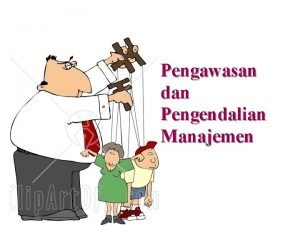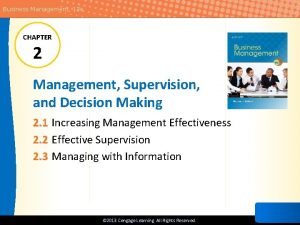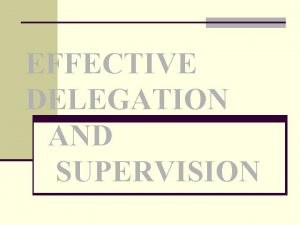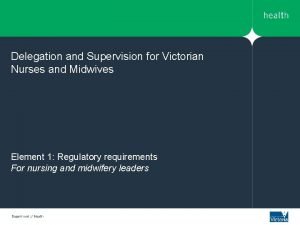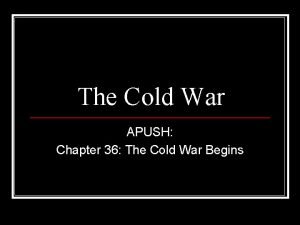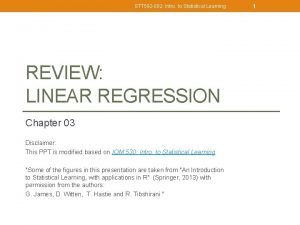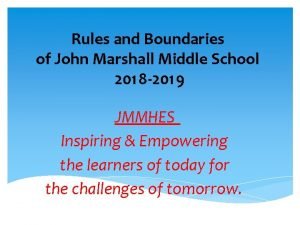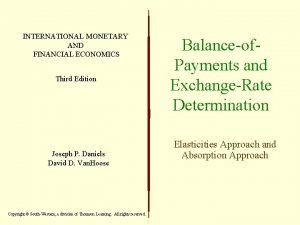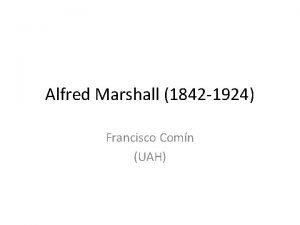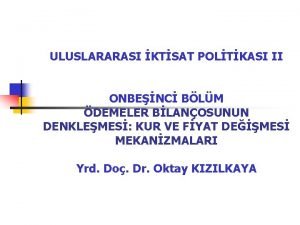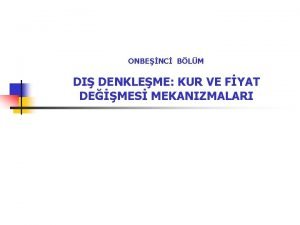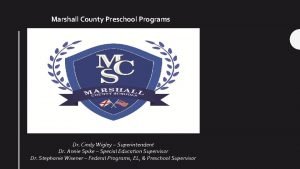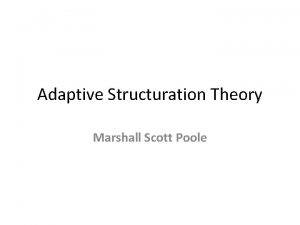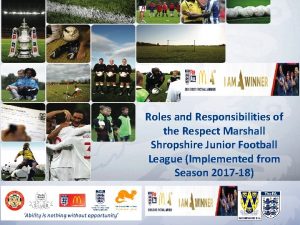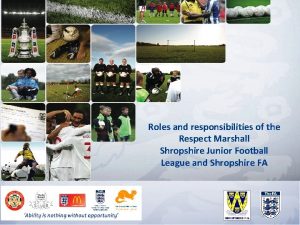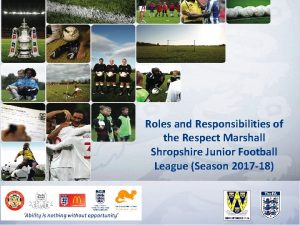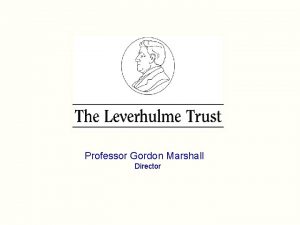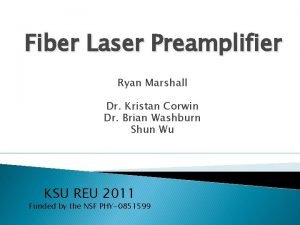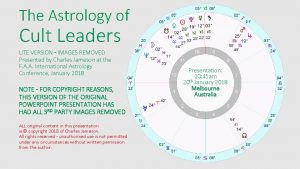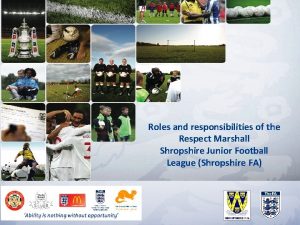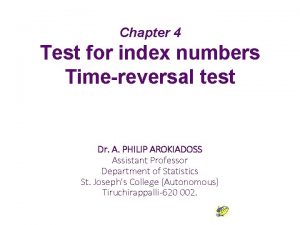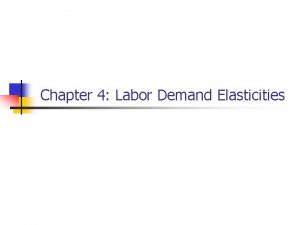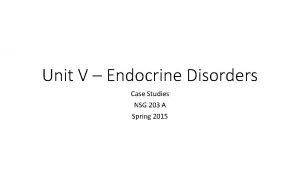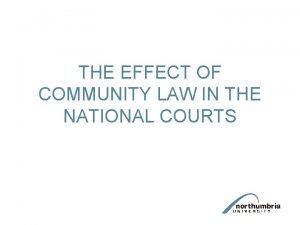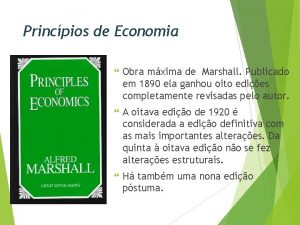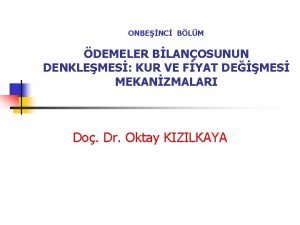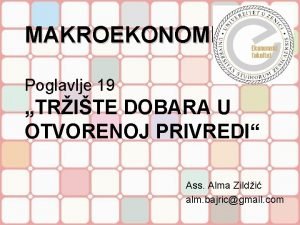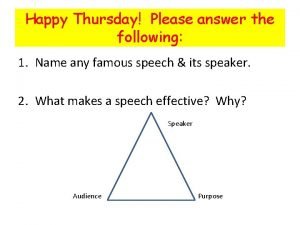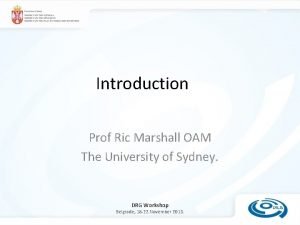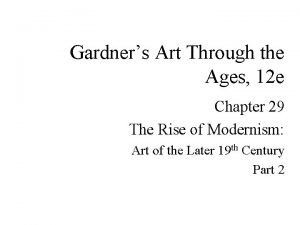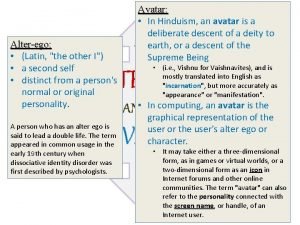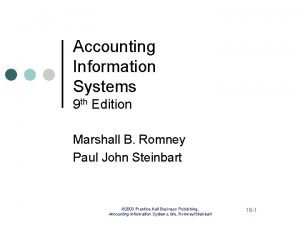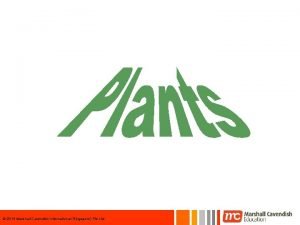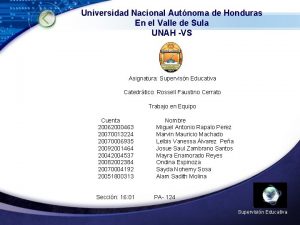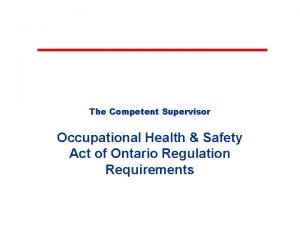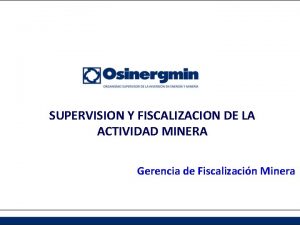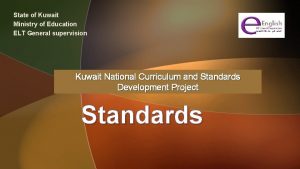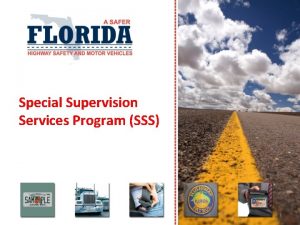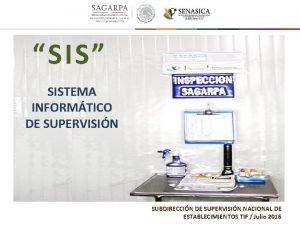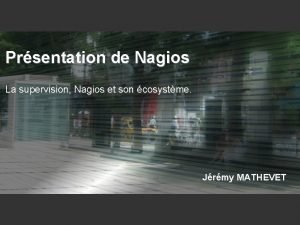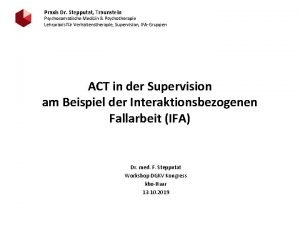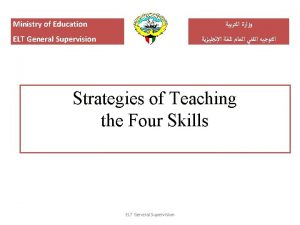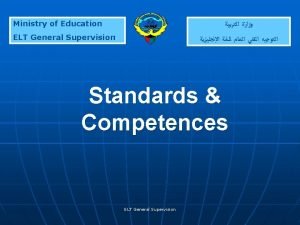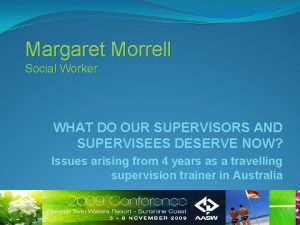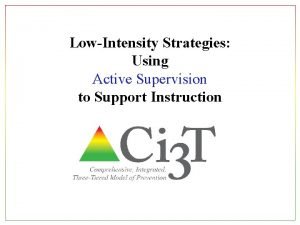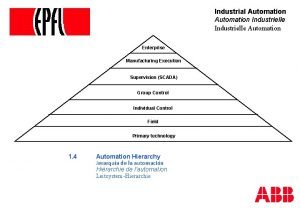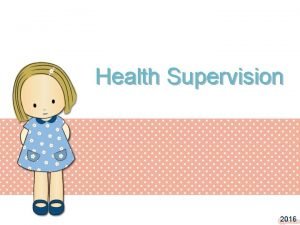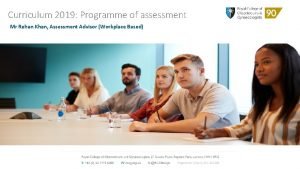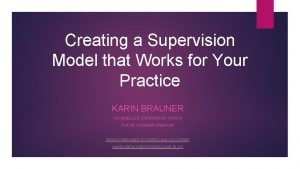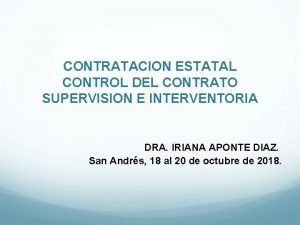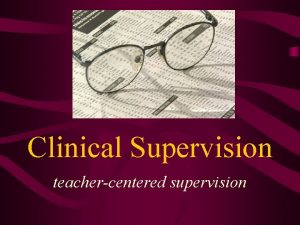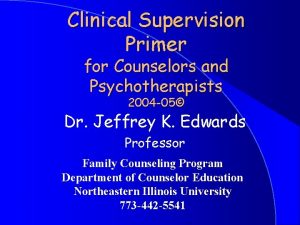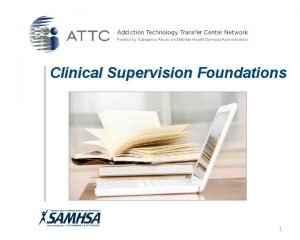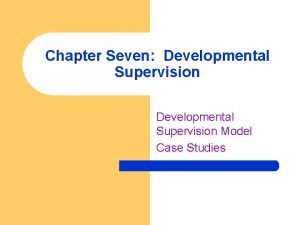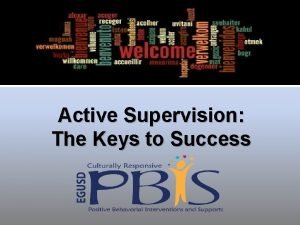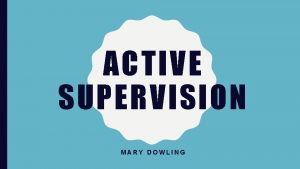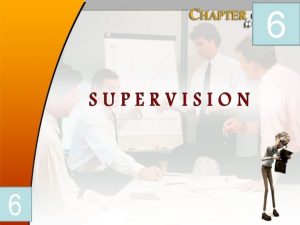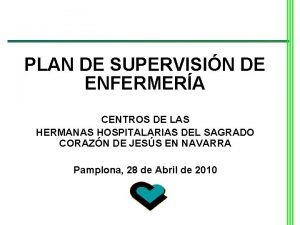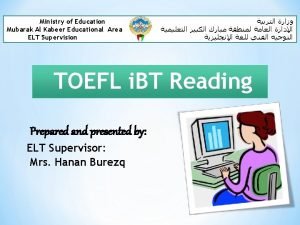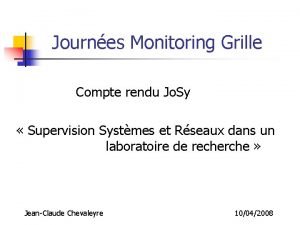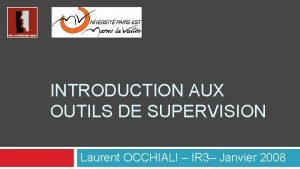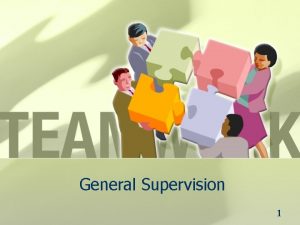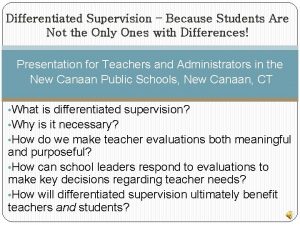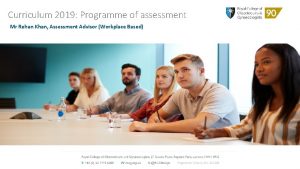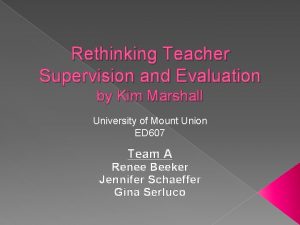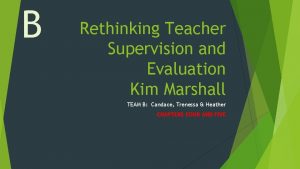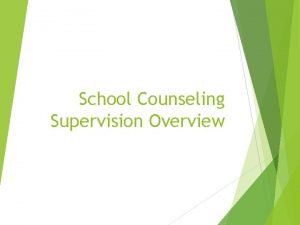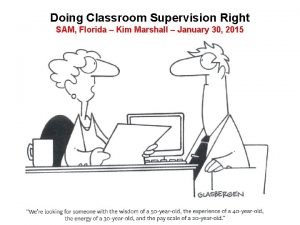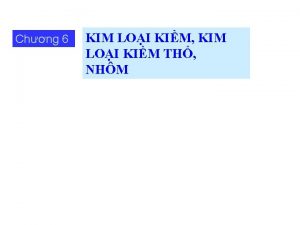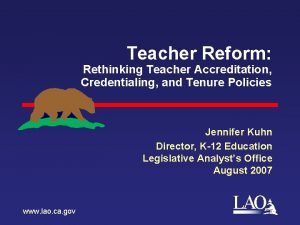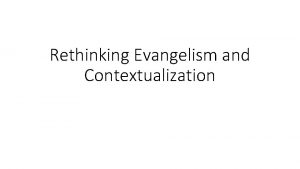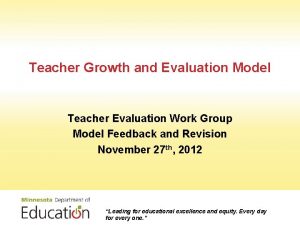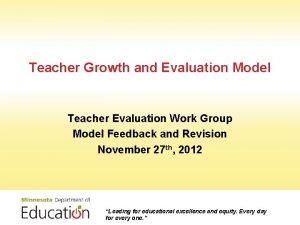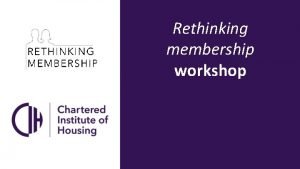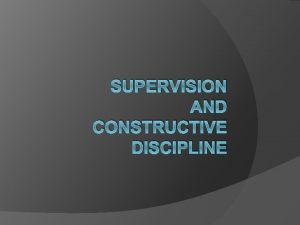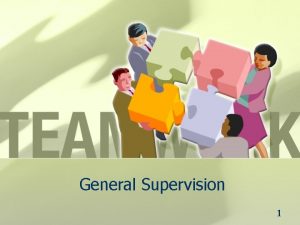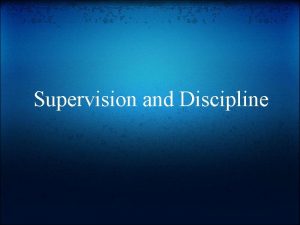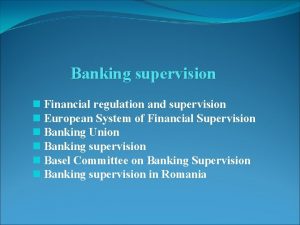Rethinking Teacher Supervision and Evaluation DudleyCharlton Kim Marshall























































































































































![D. Monitoring, Assessment, and Follow-up [Effective level] - Posts clear criteria for proficiency, including D. Monitoring, Assessment, and Follow-up [Effective level] - Posts clear criteria for proficiency, including](https://slidetodoc.com/presentation_image/40ea6f733c7e5626ebc34b7b317919c4/image-152.jpg)






















- Slides: 174

Rethinking Teacher Supervision and Evaluation Dudley-Charlton – Kim Marshall – April 29, 2011 1

Your role? 1. Principal 2. Assistant principal 3. Teacher 4. Union official 5. Instructional coach 6. District official 7. Consultant 8. Education advocate 9. University or college 10. Other 10

Approximate FRPL of your students 1. 0 -10% 2. 11 -20% 3. 21 -30% 4. 31 -40% 5. 41 -50% 6. 51 -60% 7. 61 -70% 8. 71 -80% 9. 81 -90% 10. 91 -100% 9 Answer Now

Percent of New York 7 th-graders proficient and above in ELA, and FRPL 4

What are the two biggest factors in achievement in low-SES schools? 1. Differences in class size 2. Strict discipline 3. Sense of mission 4. School leadership 5. Teaching practices 6. Curriculum content 7. Parent involvement 8. PD, coaching 9. Teachers’ credentials 10. Staff morale 8

As a teacher, which two most improved your teaching and your students’ learning? 1. 2. 3. Ideas from books, articles PD workshops in school Workshops and courses outside school 4. Supervision suggestions from administrators 5. End-of-year evaluation by administrators 6. Ideas and suggestions from fellow teachers 7. Ideas and suggestions from loved ones 8. Internet resources 9. Figuring it out myself 10. Other 7

Evaluation has become a polite, if near-meaningless matter between a beleaguered principal and a nervous teacher. Research has finally told us what many of us suspected all along: that conventional evaluation, the kind the overwhelming majority of American teachers undergo, does not have any measurable impact on the quality of student learning. In most cases, it is a waste of time. Mike Schmoker, 1992 Except for a few instances, the traditional evaluation process is exhausting and fruitless. Kathleen Elvin, Brooklyn principal, 2008 Principal evaluation of teachers is a low-leverage strategy for improving schools, particularly in terms of the time it requires of principals. Richard Du. Four & Robert Marzano, 2009 7

Your reaction to these statements? 1. Strongly Agree 2. Agree 3. Neutral 4. Disagree 5. Strongly Disagree 6 Answer Now! 8

Widget Effect – New Teacher Project • Chicago teacher ratings 2003 -08 on 4 -point scale: – Superior – 25, 332 – Excellent – 9, 176 – Satisfactory – 2, 232 – Unsatisfactory – 149 • Elgin teacher ratings 2003 -08 on 3 -point scale: – Excellent – 2, 035 – Satisfactory – 264 – Unsatisfactory – 11 • Denver ratings 2005 -08 on binary scale: – 2, 374 Satisfactory – 32 Unsatisfactory 9

A summary • Quality of teaching is hugely important to kids’ futures. – Especially is they have any kind of disadvantage. • 99% of U. S. teachers are rated Excellent or Satisfactory. • But there’s plenty of mediocre and ineffective teaching. • We’re not differentiating excellent, good, mediocre, poor • A mediocre hotel isn’t a big deal, but with teaching… • We’re not helping mediocre/unsatisfactory teachers… • And the evaluation system is exhausting principals.

Saints, cynics, and sinners • Saints spend 6+ hours per teacher. – Pre-observation conference, observation, writeup, post-conference • Cynics bang out observations/evaluations. – Tedious, won’t make much difference, but… • Sinners don’t do them (except when the heat is on). – Usually get away with it 11

12

13

14

Bill Ribas, Teacher Evaluation That Works, 2005 15

Which category describes the principal you know best? 1. Saint 2. Cynic 3. Sinner 5 Answer Now! 16

The $64, 000 Question • Could a saint’s school have low student achievement? – The story of one principal in New York City • Could a sinner’s school have high student achievement? 17

The challenge • How can principals sample teaching accurately? • Positively influence teaching? • Assure quality teaching in every class, every day? • Boost learning for all students? • Is this humanly possible? 18

Each teacher teaches 900 lessons a year 19

How to supervise this kind of work? • Police departments have a similar challenge • Very difficult to keep tabs on police officers • How do you make sure they’re doing the right thing all the time? • How do you motivate them to do want to do the right thing all the time? – Rigid policies and procedures – “officer-proof” – Supervisors cruising around checking up – Compstat – using crime statistics, arrests - results – Video cameras in patrol cars 20

Teachers are on their own 99. 9% of the time; many are great, many are not. What to do? • Hire more administrators to evaluate more frequently • “Master Educators” from central to evaluate teachers • Evaluate teachers using value-added test scores • Wyoming proposal: once-a-year videotaping • Cameras monitoring classrooms all the time • Student input; parent input • A 4 -year evaluation cycle • Trust in teachers’ professionalism • Prayer 21

Logic model – how it could work A. A shared definition of good teaching B. Principals see everyday teaching in action. C. Principals are knowledgeable and perceptive observers. D. Principals have an effective way to give feedback. E. Principals address mediocre and ineffective teaching. F. Teachers hear and accept the feedback. G. Teachers take ownership for student learning. 22

A. A shared definition of good teaching • Every district has criteria in its evaluation form. • Required presentation to teachers, sign-off • But does everyone pay attention, buy in? • A common problem: defining just one level. 23

Is there agreement on good teaching in your school? 1. We all agree on what excellent, good, mediocre, poor teaching looks like. 2. We agree on what good teaching looks like. 3. There are some disparities within the school. 4. There are many different opinions on what good teaching is. Answer Now! 7 24

Teachers are immune to feedback from a coach or administrator when they have different definitions of quality. The single most important thing that a school leader can do is reach agreement with the staff about quality. Fisher and Frey, 2010 25

B. Principals see everyday reality • Factors that make this difficult: – H. S. P. S. – evaluation avoided, procrastinated – Principals see only 0. 1% of teaching – The principal’s presence changes things. – Announced observations, “glamorized” lessons A “collusive deal” – utterly bogus Restaurant owner’s concerns… • It’s what teachers do every day that boosts learning. – Like healthy eating, exercise – keeping it up 26

It has been said that when a principal walks into a room, it has the same effect as seeing a state trooper pull out onto the highway – the students straighten up and “take their foot off the gas”, even if they weren’t speeding (er, misbehaving). Peter Hall, Nevada principal (2005) 27

In your school, how many formal teacher evaluation visits are announced in advance? 1. All of them 2. About 75% 3. About half 4. About 25% 5. None of them 6

In defense of pre-announced visits “I want to see teachers at their best. ” “It is my firm belief that mediocre teachers will hang themselves whether announced or unannounced. ” “I have never met a bad teacher who didn’t look horrible despite an announced visit. ” 29

30

C. Principals are knowledgeable and perceptive observers of teaching • A shared definition of good teaching helps. • So does knowledge of curriculum goals, calendar, ideas • Touring classrooms with thoughtful colleagues helps. • Best of all: being in classrooms a lot, talking to teachers, and looking at student learning. • Most principals don’t do enough of this. 31

D. An effective way to give feedback • Often low-quality forms, checklists • Teacher signs, files away – little impact • High skill level needed to do good lesson write-ups. – Lots of words without clear judgment, feedback. – Plus it’s time-consuming, exhausting for principals • Some principals have teachers draft their evaluations. • Some cut corners, paste in boilerplate 32

Your opinion of your district’s end-of-year teacher evaluation form? 1. Excellent tool that improves teaching 2. Good feedback tool 3. Not bad but doesn’t affect teaching much 4. Poor tool that doesn’t capture good teaching or help teachers improve 6

Problematic models • • • Narratives – verbiage without impact Teacher goal-setting – very hard to follow up Checklists – perfunctory, don’t distinguish 4 -3 -2 -1 Quality descriptions with no rubric Binary ratings – Satisfactory/Unsatisfactory Three-point scales: – Excellent – Satisfactory – Unsatisfactory • Five-point scales: “Gentleman’s C”

35

36

E. Principals step up to the plate on mediocre and ineffective teaching • Some don’t push teachers to be better. • Want to keep the peace, avoid conflict, be liked • Fear of grievances, lengthy proceedings • Afraid of jeopardizing other initiatives. • Wait for them to retire. • And some teachers are scary… 37

38

F. Teachers hear and accept the feedback • Can be overwhelming – too much feedback to absorb • Many teachers shrug off criticism. • Lots of reasons to ignore a principal: – You’re hardly ever in my room. – You haven’t taught in years. – You never taught my grade level/subject. – You don’t have children of your own. – I was having a bad day. • Criticism makes some teachers shut down… 39

40

G. Teachers take ownership for student learning • Many teachers work in isolation. • Little ownership for the school’s mission • For many, evaluation is paternalistic, top-down. – Impressing, charming, getting over on boss • It’s about instructional inputs, which are debatable. • How to instill intrinsic motivation? • Get teachers focused on learning, finding the most effective methods and materials, always improving? 41

Dependency • Paternalistic • Glamorized lessons • Winning the boss’s approval • “I liked when you…” • Lesson plans turned in • Data analysis because we have to • CYA • Working in isolation Results • • Shared vision, mission Team unit planning On-the-spot assessments Common interim assessments • Immediate team analysis, action plans • Supervisory voice in head all the time • Continuously improving 42

In short, the logic model isn’t working • No school effectiveness lists include supervision/eval. • Marzano, Du. Four, Saphier: a “weak lever” for change • Core problem: full-lesson evaluations that are infrequent, announced, time-consuming, not focused on results • Lots of mediocre, ineffective teaching under the radar • How can we get good teaching in every class, every day? • Here’s my 4 -part proposal… 43

I. MINI-OBSERVATIONS • Principals need a system for: – Getting into classrooms – Seeing everyday reality – Giving teachers meaningful feedback – Continuously improving student learning – Gathering data for year-end evaluations • Many are racked with guilt about not doing this. 44

Mini-observations: systematic, frequent sampling and coaching • Short visits to fit them in to very busy days • Unannounced to see what kids are experiencing daily • Lots of them to sample all aspects of teaching, blend in • Prompt, thoughtful feedback to each teacher • Informal and low-stakes to maximize adult learning • Systematic cycling through the whole staff • Integrated with team unit planning and results analysis 45

Like a Gallup Poll 46

Still not much time, but… • Much more representative than one dog-and-pony • A random sampling is amazingly accurate. • And this is as much as most principals can do. • My challenge: What’s the alternative? • We still rely on teachers’ professionalism, skill. • But by frequently checking in and giving feedback • Message: It’s what you do every day that matters. 47

About how often is the average teacher visited and given feedback in your school? 1. Never 2. Once every two years 3. Once a year 4. Twice a year 5. 3 -5 times a year 6. 6 -8 times a year 7. About once a month 8. About every two weeks 9. Once every week 10. More than once a week Answer Now 5

Why not call them “walk-throughs”? • Confusion with learning walks - a team touring the whole building, general feedback (Resnick, Elmore) • The wrong term for a focused, thoughtful observation with feedback – sounds to teachers like a drive-by. • Video clip Safety walkthrough Showing the flag Learning walk/ Instructional rounds Miniobservations Full-lesson observation

Education Week, March 12, 2008 50

What might worry teachers about mini-observations? • If you were introducing this idea, what concerns would you predict? • What might principals worry about? • Brainstorm in groups of 2 -3 • Jot down your key points for a kick-off meeting. 51

Nine key success factors • Staying long enough to gather helpful information • Making enough visits to get a balanced picture • Having a clear sense of what to look for • Capturing and remembering key insights • Giving feedback in a way teachers can hear and accept • Stepping up with criticism, not accepting mediocrity • Shifting gears with unsatisfactory teaching • Being clear that mini-observations are evaluative • Explaining mini-observations to teachers 52

How long depends on your purpose • Showing the flag: 5 seconds • Checking on a substitute: 6 seconds • In-depth professional development: 45 min. + • Making the case for dismissal: multiple 45 min. • But what about a dialogue about instruction? 53

How long does a principal need to stay to form a meaningful impression? 1. 2. 3. 4. 5. 6. 7. 8. 9. 10. 1 minute 3 minutes 5 minutes 10 minutes 15 minutes 20 minutes 25 minutes 35 minutes 45 minutes 1 hour or more 5 Answer Now! 54

55

56

Videotape and role-play preferred grade level? 1. Kindergarten 2. Grade 4 -5 3. Middle school 4. High-school English 5. High-school science 5 Answer Now

Was that enough time to get a sense of what was going on in the classroom? 1. Yes 2. No 5 Answer Now! 58

Was it possible to give meaningful feedback to the teacher afterward? 1. Yes 2. No 5 Answer Now! 59

Best range: 5 -15 minutes • Depending on: – How many teachers – How many administrators doing mini-observations – Discipline issues • 5 minutes worked for me with 42 teachers to supervise • I could fit them into the nooks and crannies • But not too short! Principal who sees all classes 2 nd per. • Note: no pre-observation conferences 60

So who does full-lesson observations? • All teachers should have them periodically. – Instructional coaches (also co-observe with principal) – Peer observers – Lesson study colleagues – Videotaping lesson, watching with a critical friend • New teachers need more detailed feedback. • But principal only does unsatisfactory teachers. 61

2. Doing lots • A good annual target: 10/teacher/year – Seeing each teacher every 2 -3 weeks – Sampling all aspects of instruction • Frequent visits build dialogue, candor, and trust. • How? Set a daily target number and keep it up! • My track record: 11, 12, 14, 12, 7, 12, 11+ 62

Do the math for your staff # of teachers Minis for year # per day Stretch goal 60 600 3. 3 4 50 500 2. 7 3 40 400 2. 2 3 30 300 1. 7 2 20 200 1. 1 2 10 100 . 6 1

A hypothesis on frequency • The less frequently a principal visits classrooms… – The more chance for an inaccurate impression – The riskier for teachers – caught in a bad moment – The more teachers do their own thing – The more teachers get into bad habits • The more frequently a principal visits… – The more accurate a picture of daily instruction – The safer for teachers – accurate sampling – The more thoughtful the feedback – The better the quality of instruction 64

Refinements and variations • Mixing up morning, mid-day, and afternoon visits • Arriving at beginning, middle, or end of lessons • Doing a grade-level team in a single day • Deciding to stay longer • “Intensives” – Herb Daughtry • Following one class through an entire day • Others? 65

Which strategy would help you keep up mini-observations all year? 1. Will power 2. My boss being on my case 3. A daily target number of visits 4. A weekly target 5. Tracking data 6. Rewarding myself 7. A bare office 8. Other 5 Answer Now! 66

The boss’s support really helps • Regularly visiting, asking good questions – How’s it going? Hitting target? What noticing? • Very helpful if it’s a district policy – Seen as a best practice, frequently discussed – Training and support, watching videotapes • Also, taking something off the table! – Like what? 67

3. Knowing what to look for • Can’t use the end-of-year evaluation checklist, rubric – Too much to look for – Only seeing a lesson fragment; not fair or practical • Many mini-observation checklists are being developed. – e. COVE, i. Observation, others • Problem: the principal is rating, evaluating • Schoolwide or systemwide data gathering, but does that help the individual teacher. Is it good coaching? 68

69

70

71

A hypothesis on checklists • The more detailed and elaborate the checklist… – The more constrained the principal – The more consumed with recording data – The less perceptive in observing students, tasks – The less seriously teachers take the feedback – The less frequent are classrooms visits • The simpler and clearer the vision of good teaching… – The more observant principal is – The more focused on a few key change levers – The more seriously teachers will take the feedback – The more frequently visits will occur 72

“You can observe a lot by watching” • Slowing down, breathing, listening, paying attention • Not imposing a checklist on the situation – This teacher in this classroom in this moment • What’s most important? What deserves feedback? – Capturing 1 -3 thoughtful points • So as not to miss anything, a mental checklist helps. – The irreducible elements of good teaching… – With a clear sense of your red flags on each 73

S - Safety O - Objectives T - Teaching E - Engagement L - Learning 74

The L in SOTEL • Ultimately, year-end state tests, but in real time? • Teachers’ checking for understanding • Looking at the learning task (City, Elmore, et al. ) • Asking a student “What are you working on? ” • Teacher teams looking at student work • Teacher teams looking at interim assessments • One-on-one principal/teacher chats with work 75

4. Capturing insights • You don’t want to forget important stuff. • For example, COPWAKTA, great moment, low rigor • Clipboards, checklists, i. Phones, laptops can distract. • Plus, you can miss the forest for the trees. • The key: Being a good observer! • Not missing the big picture! One or two key points only. • Jot notes later? 76

77

78

Which would you as a teacher prefer your principal to use? 1. Checklist on a clipboard 2. Notepad 3. Laptop 4. Black. Berry 5. i. Pad 6. Flip video camera 7. Recording device 8. No writing in class 9. Doesn’t matter 5 Answer Now! 79

5. Giving feedback that will make a difference • After a mini-observation, there’s lots to say: – Praise, on-the-edge, reinforcement, suggestions – Questions, redirection, criticism, reprimand • What’s the best way to deliver the feedback? • How soon? • Where? 80

Some possible approaches • No feedback to the teacher; supervisus interruptus • Memo to whole staff showcasing best practices • Post-It note on teacher’s desk on the way out • Hand-written feedback in mailbox • Checklist filled out, in teacher’s mailbox • Palm Pilot electronic checklist sent to teacher • E-mail later that day • Face-to-face conversation soon afterward 81

The trouble with written feedback In e-mail, people talk at you; in conversation I can talk with [people], and a casual remark can lead to a level of discussion that neither party anticipated from the beginning. I am more likely to learn from someone in a conversation than in an e-mail exchange, which simply does not allow for the serendipity, intensity and giveand-take of real-time interaction. Steven Levy, Newsweek, June 11, 2007 82

Especially in our digital age, the power of talking to people in person is exponential. Howard Schultz Starbucks founder 83

9 advantages of face-to-face • Can quickly and efficiently cover a lot of ground • Less paperwork • Less threatening than written, less bureaucratic • Focus on 1 -2 key points, teacher not overwhelmed • The teacher can push back, informal dialogue. • Can be tentative, check on something (girl’s card) • Can judge if the teacher can handle criticism. • Can segue into general talks about instruction, status. • Much more likely to change ineffective practices 84

Four-squares feedback What’s going well Any concerns Next steps What I can do? 85

Informal, somewhat humble posture • Stand-up chats are lighter, less threatening. – Brief – 30 seconds to 5 minutes; don’t overdo it! – Not an all-seeing, all-knowing, judgmental god • “I was only there for ten minutes; here’s what I saw. ” • “I’m curious about what happened after I left…” • Really listening to how the teacher responds – Give-and-take, suggestions, commendations 86

Feedback in writing? Signature? • Feels bureaucratic, CYA to the teacher • Less nuanced, detailed than face-to-face • Teacher not invited into the conversation • Face-to-face is quicker, more direct, more powerful. • Signature only if there’s a red flag – “letter to file” • How about this sequence: – Mini-observation – Face-to-face conversation – A short e-mail to the teacher summing up 87

Nine ineffective practices • Intervening with students – “Excuse me, …” • Giving the teacher “private” feedback on the spot • Sending e-mail feedback from a laptop while in class • Written feedback that “ends there” • Several-day delay before giving feedback • Bureaucratic checklist, robotic use of technology • Distracted – “He’s there but he’s not there. ” • Perfunctory – I’m checking you off my list. • Not giving all teachers feedback all the time • Arizona district: trio visit, pullout, demo 88

Which is most likely to improve teaching and teachers’ investment in improving? 1. 2. 3. 4. 5. 6. 7. 8. 9. 10. No feedback Verbal feedback during class Post-it note on desk Memo to staff on best practices Checklist in mailbox Electronic checklist Written comments in mailbox or e-mail Face-to-face talk Written comments, then face-to-face Face-to-face, then written comments 5 Answer Now! 89

Best location for mini feedback? 1. 2. 3. 4. Principal’s office Corridor Playground Teacher’s classroom during free period 5. Cafeteria 6. Faculty lounge 7. Parking lot 8. A bar after hours 9. A phone call in evening 10. Other Answer Now 5

Avoidance • I’m too busy! • Can’t track down teachers. • Will I have enough to say? Bite the bullet on criticism? • I’m more comfortable with a checklist, e-mail • Another reason: binge mini-observing 91

“I made it my business” • “Face-to-face feedback is the driver of change. ” Paul Bambrick-Santoyo, 2010 • If it’s perceptive and delivered well, it can really affect teaching and learning. • Being strategic about tracking down teachers. • And following up on subsequent visits, chats 92

Scheduled check-in meetings? • Each teacher has a scheduled meeting time • Do mini-observations shortly before check-ins • Use the check-in to give feedback • Also to have a more general How’s-it-going talk • Helps keep principal on track • Any disadvantages? 93

Linking to school-wide improvement • The principal can be a cross-pollinator! – Spread good ideas, things to avoid, think about – Organize PD on specific areas – Put teachers in touch with each other – Peer observation • Pass along insights to teams, instructional coaches. – Talk about units, student learning. 94

6. Stepping up to the plate 95

A leader who is silent on mediocrity speaks loudly • Some teachers get into bad habits, slack off - mediocrity • Addressing mediocre and poor teaching depends on: – A clear, shared vision of effective teaching – Urgency – good teaching really, really matters – Guts • How to keep our moral edge? – Co-observe classrooms with your boss – Regularly look at interim assessment results 96

Pointers from Thomas Hoerr (2004) • Pick the time and place carefully. • Be timely. • Be specific. • Watch your body language. • Tell why this is important to you and the school. • Say that you’ve been there too. • Allow for a response. • Review and reinforce at the end. 97

7. Shifting gears with unsatisfactory teaching • Mini-observations aren’t sufficient. • Full-lesson observations, ideally unannounced • Union reps, lawyer consulted at every step • Diagnosis and prescription, improvement plan • 2 -3 chances to improve, plenty of support • If insufficient improvement, dismissal 98

8. A clear, explicit link to end-of-the-year evaluations • It’s understood that mini-observations are evaluative. – No firewall between minis and evaluation. • It’s all part of improving teaching and learning. • This may require collective bargaining or a waiver. • At the Mather, there was rapid acceptance of the idea. • People trusted I was seeing reality, feedback was honest. – We did away with the dog-and-pony show! – Which opened up time for mini-observations. 99

9. A clear explanation to teachers • Launch with a good rationale – What’s the problem to which this is the solution? – Old system is chewing up time and is ineffective – Change will help our school’s mission. • Reassure teachers on the key worries. • Show a videotape! It really helps make the point. • In the first couple of cycles, accentuate the positive. 100

101

The logic of mini-observations • Unannounced to see everyday reality. • But it would be unfair to observe just once a year. • So observations must be frequent to sample accurately. • But if frequent, don’t have time to stay for full lessons. • So observations need to be short. • But visits are short, full write-ups aren’t possible. • So brief, face-to-face feedback and follow-up e-mails. • But it’s easy to lose track, miss teachers, double up. • So the process must be systematic. 102

Advantages for teaching and learning • See reality without distortion (no glamorized; blend in) • Get to know how all teacher are doing, spot problems • CEO visibility, listening, getting ideas, credibility • Build trust, the lubricant of school culture • Unspoken message: everyday teaching is what matters • I’m your coach; let’s solve problems together. • More humble, winning posture – teachers hear, accept • Good time management – squeezed into busy days • Gathering anecdotes for meetings, parents • Lots of information for year-end evaluations 103

How would you personally feel about being supervised using mini-observations? 1. Strongly prefer this approach 2. Prefer it 3. No difference one way or the other 4. Uncomfortable with it 5. Very negative about it 5 Answer Now! 104

With 10 -12 mini-observations with feedback a year, would you have a pretty accurate picture of each teacher’s performance? 1. Yes 2. No 5 Answer Now! 105

How much impact would this have on teaching and learning? 1. Very positive 2. Somewhat positive 3. Not much impact 4. No impact 5 Answer Now! 106

II. SUPERVISING CURRICULUM UNIT PLANNING 107

108

To be a good mini-observer, it helps to know the curriculum • A razzle-dazzle lesson, but does it… – Align with standards? Big ideas? – Contain the appropriate level of rigor, detail? – Get at the big ideas, essential questions? • Principals can’t micromanage every lesson. – 25, 000 a year! • But can monitor teacher teams’ curriculum unit plans 109

110

111

112

113

Key to increasing teacher ownership • Teacher teams (e. g. , Grade 3, 7 th-grade social studies) • Starting with the end in mind: a shared vision of what students should know and be able to do • Planning each 4 -6 week curriculum unit in advance • Principal reviewing drafts, dropping in • Instructional coaches supporting teacher teams 114

A difference in tone • Asking for lesson plans feels officious, untrusting. • Working with teams on unit plans is stimulating and productive work. • It’s also much more manageable! • Essential Questions are better for classroom walls than SWBAT lesson objectives. 115

Some insights on backwards design • It won’t happen by itself. • It pushes teachers to plan deeper, more thoughtfully. • It’s challenging intellectual work, best done in teams. • It builds collaboration, investment in the mission. • It’s the best way to integrate standards. • It gets higher-order, college-ready ideas into lessons. • Much easier to supervise unit plans than lesson plans 116

A simplified unit planning template 1. State standards (written out verbatim, unpacked) 2. Knowledge goals - Students will know… 3. Skill goals - Students will be able to… 4. Big ideas - Students will understand that… 5. Essential Questions (3 -4 in kid-friendly language) 6. End-of-unit assessments (written up front) 7. Lesson-by-lesson instructional plan See sample fifth-grade nutrition unit 117

Some key leadership steps • Clarity on end-of-year learning goals for each grade • Having teams decide on units, calendar them • Insisting that teacher teams collaboratively plan units • Providing a simple unit planning template, model unit • Giving teams the time to plan • Making sure teachers start with the standards • Reviewing unit drafts, revising, visiting meetings • Subscribing to www. ubdexchange. org, www. betterlesson. org, providing Ub. D training, support 118

What is the potential of backwards unit design in your school? 1. We’re doing this already. 2. It would greatly improve the quality of teaching and learning. 3. It would bring about some improvements. 4. It wouldn’t make much difference. 5. It would confuse and overload teachers. 5

How does involvement in unit planning affect teacher supervision? 1. It makes the principal a more perceptive and helpful observer. 2. It gives the principal a little more of an idea of curriculum content. 3. It turns the principal into a desk-bound curriculum bureaucrat. 4. Principals don’t have the time to get this involved in curriculum. Answer Now 5

Synergy with mini-observations 121

III. INTERIM ASSESSMENTS: Introducing student learning into supervision and evaluation 122

123

124

Mini-observations and curriculum units: Necessary but not sufficient • It’s not enough to get into classrooms a lot. • It’s not enough to have good curriculum unit plans. • Are students learning? • This must be part of supervision and evaluation. • But how? • A national debate is raging. 125

Problems with individual merit pay • Practical – Test scores not available till summer. • Psychometric – Tests not valid for individual evaluation. • Value-added – We need three years of data for validity. • Staff dynamics – Collaboration is undermined. • Curriculum quality – Low-level test prep. • Moral – Turning up the heat increases cheating. • Fairness – How to divvy up credit among all the teachers who contribute to students’ success? 126

But isn’t there some way? • Here’s why it matters. • The moment of truth in classrooms • A teacher teaches a curriculum unit, assesses learning

Inexorable gap-widening forces • Pressure to cover the curriculum, prepare for tests • Pressure from parents of high-achieving students • Beliefs about intelligence • Fatalism about the bell curve • Shortage of ideas, materials to help those kids • Isolation from colleagues… • How can we stop the gap from widening? 128

129

130

131

“Professional Learning Communities” good interim tests, analysis, action • Same-grade, same-subject teacher teams collaborating • Common goals, interim assessments every 6 weeks – Immediate scoring and data display • Collegial sharing on what worked, what didn’t – Non-evaluative to foster adult learning • Grappling with student misconceptions, learning problems • This gets teachers really invested. 132 • The engine of improvement in high-achieving schools.

133 Visible Learning by John Hattie (2009)

134

135

8 keys to success with interim assessments • High-quality tests, well aligned, appropriate rigor • Rapid turnaround (24 hours) • Clear, graphic data display • Productive team data meetings, “data without blame” • Administrator/coach involvement, support - video clip • Honest reflection, continuous improvement • Immediate follow-up with students • Students involved: knowing status, setting goals… 136

137

138

139

140

Principals are the key orchestrators • Building understanding and trust • Insisting on common interim assessments • Scheduling assessments, team meetings, follow-up • Ground rules to keep focused, low-stakes • Team leaders facilitate; principal drops in, supports • Young administrator’s entry point: results vs. methods • Teachers hold each other accountable for high quality. • “Man on Fire” swimming sequence 141

Agile teaching, responsive to student learning minute by minute, day by day, month by month. Dylan Wiliam and Ian Beatty, 2009 142

What is the potential of interim assessments in your school? 1. We’re doing this now. 2. If done well, this would bring about major improvements in teaching and learning. 3. It would have some benefits. 4. Teacher teams are resistant to this kind of work. 5. Interim assessments would have a negative impact on our school. Answer Now 5

How about the principal’s role in interim assessments? 1. Shifting the conversation to results is key to effective supervision and leadership. 2. The principal should help guide this process but not lead it. 3. The principal should let teachers handle assessments. 4. Principals don’t have the time or expertise to do this kind of work. Answer Now 5

Three kinds of supervision interact 145

IV. TEACHER EVALUATION RUBRICS 146

End-of-year evaluation • After doing 10+ mini-observations with feedback… • After working with teams on curriculum unit plans… • After working with teams on interim assessments… • How to sum up a teacher’s performance for the year? • Narratives, checklists, and goals all have problems… • Must differentiate between great, good, mediocre, poor • Recognize quality, give tough-love feedback to others 147

Teacher evaluation rubrics • Rubrics spell out four levels of teaching quality. • They force judgment. • A road-map to help underperformers to improve • Charlotte Danielson: Framework for Teaching, 1996 • Some districts, charter schools using rubrics • Endorsed in Education Sector report, Rush to Judgment • Big advantages over write-ups, checklists, goal-setting 148

Kim’s rubrics (2006, 2010) Open source • Researched rubrics, best ideas, step-by-step process: • First, deciding on “buckets” based on many models: A. Planning and preparation for learning B. Classroom management C. Delivery of instruction D. Monitoring, assessment, and follow-up E. Family and community outreach F. Professional responsibilities 149

The rating scale and labels 4 – Highly Effective 3 – Effective 2 – Improvement Necessary 1 – Does Not Meet Standards • Differentiate the four levels of performance • The goal – all teachers performing at Level 3 and 4 • Identify master teachers for maxi roles in school • Intervene with mediocre and ineffective 150

Sorting and drafting • A wide search for the criteria of good teaching • Finding the most powerful, best written • The inputs that lead to high student achievement • Sorting them into the six “buckets” • Drafting Level 3 (Effective) • Short and sweet! 151
![D Monitoring Assessment and Followup Effective level Posts clear criteria for proficiency including D. Monitoring, Assessment, and Follow-up [Effective level] - Posts clear criteria for proficiency, including](https://slidetodoc.com/presentation_image/40ea6f733c7e5626ebc34b7b317919c4/image-152.jpg)
D. Monitoring, Assessment, and Follow-up [Effective level] - Posts clear criteria for proficiency, including rubrics and exemplars of student work. - Diagnoses students’ knowledge and skills up front and makes small adjustments based on the data. - Frequently checks for understanding and gives students helpful information if they seem confused. - Has students set goals, self-assess, and know where they stand academically at all times. - Regularly posts students’ work to make visible and celebrate their progress with respect to standards. - Uses data from interim assessments to adjust teaching, re-teach, and follow up with failing students. - Takes responsibility for students who are not succeeding and gives them extra help. - When necessary, refers students for specialized diagnosis and extra help. - Analyzes data from assessments, draws conclusions, and shares them appropriately. - Reflects on the effectiveness of lessons and units and continuously works to improve them. 152

Drafting the other three levels and creating headlines 153

Involving teachers • Goal: understanding, trust, investment in improvement • Rubrics negotiated, shared and discussed up front • Voluntary self-assessment and goal-setting • In May/June, each teacher fills out the rubric. • Input in areas where principal lacks information. • Meet, compare, discuss the evidence • Finalize, celebrate, set goals 154

155

Let’s try one page • Think of a teacher you know well. • Pick one domain (Classroom Management? ) • Read across each line circling 4, 3, 2, or 1 • The best description of that teacher’s performance. • What strikes you about using rubrics? – Pluses – Concerns 156

Flip through the whole package • A total of 60 facets of teaching (Danielson has 77) • Covering all aspects of the job • Judged by at least 10 mini-observations, conversations, visits to team meetings, other interactions • For teachers at Level 1 and 2, improvement plan, support • Rubrics not appropriate as classroom visit checklists! • Rubric data from a whole faculty can be very helpful… 157

158

Policy questions with rubrics • A 4 -3 -2 -1 score for each domain? An overall score? • More weight for some domains? B, C, D ? • A different rubric for new teachers? • Involving teachers, others in tweaking the rubrics? • Student input? Parent input? • Rubrics for other job categories? (Westwood, Mass. ) • Differential pay depending on rubric level? 159

Do you think teachers rated at Levels 3 and 4 produce high achievement? 1. Without a doubt 2. Probably 3. Not necessarily 4. Other factors matter more 5 Answer Now

161

Would it be OK for your child (or niece or nephew) to be in a Level 2 classroom? 1. Yes 2. No 5 Answer Now

Suggestions for Level 2 teachers • For those with an overall Level 2 rating… – No salary step raise – A year to improve to Level 3 – Lots of support – If insufficient improvement, dismissal • Being implemented in Hillsborough, Florida with strong union support 163

Ideas for rewarding teachers for results • Who gets rewarded? – Individual teachers – Teacher teams – The whole staff • What is measured? – End-of-year standardized test scores – Value-added gains in test scores – Student gains on in-school assessments – Classroom performance (observations, rubric scores) • What’s the reward? – A $$ pay bonus – Commendation in the year-end evaluation – Verbal praise from the principal 164

My suggestions • Who gets rewarded? – Individual teachers – Teacher teams – The whole staff • What is measured? – End-of-year standardized test scores – Value-added gains in test scores – Team’s student gains on in-school assessments – Classroom performance (observations) • What’s the reward? – A $$ pay bonus – Commendation in the year-end evaluation – Verbal praise from the principal 165

Highly effective teachers share their magic, boost their schools • Mentors and team leaders – They observe classes, are observed – Work with their teams on curriculum units – Work with their teams analyzing results – Mentor new teachers, struggling colleagues • Serve on the school leadership team – Write proposals, dream up new ideas – Think about policy, district issues 166

How would you personally feel about being evaluated with these rubrics? 1. 2. 3. 4. 5. Great Quite good Doesn’t matter either way Quite worried Very concerned, negative 5 Answer Now! 167

How much impact do you think using these rubrics would have on teaching and learning? 1. Very positive impact 2. Somewhat positive impact 3. Not much difference 4. Very little impact 5. Negative impact 5 Answer Now! 168

Will the logic model work now? A. A shared definition of good teaching B. Principals see everyday teaching in action. C. Principals are knowledgeable and perceptive observers. D. Principals have an effective way to give feedback. E. Principals address mediocre and ineffective teaching. F. Teachers hear and accept the feedback. G. Teachers take ownership for student learning. 169

How to make this sustainable? A principal’s time (35 teachers) • Full-dress evaluation - 300 hours (50 observations, 6 hrs each) • Mini-observations - 115 hours (4 a day, follow-up talk) • Showing the flag - 80 hours (1/2 hour a day most days) • Lesson plan inspection - 70 hours (2 hours a week) • Rubrics, conferences - 55 hours (1 hour each, 1/2 hr. conference) • Interim assessments- 50 hours (5 a year, 10 hours each) • Curriculum planning - 40 hours (six hours 6 times a year) • Learning walks/rounds - 12 hours a year (4 hours x 2 + 1 processing) 170

171

The most powerful activities - 260 hours 172

Instructional leadership on the hoof • • • Early-morning e-mailing, paperwork, calls Out front greeting colleagues, students, parents Quick meeting with leadership team, secretary 2 -3 mini-observations; face-to-face feedback to 2 -3 Monitoring the “big rock” projects for the year Dropping in on a teacher team doing unit planning Dropping in on a team looking at data, student work Cafeteria time and other interaction with students Private conversations with students, teachers, parents Outside at dismissal having informal chats, unwinding 173 Late afternoon e-mailing and paperwork

Work smart, build collaboration, close the achievement gap! 174
 Kim marshall rubric
Kim marshall rubric Difference between monitoring and evaluation
Difference between monitoring and evaluation Intro lll
Intro lll Rethinking engineering education: the cdio approach
Rethinking engineering education: the cdio approach Rethinking the 4 p's
Rethinking the 4 p's Ubígua
Ubígua Rethinking education: towards a global common good?
Rethinking education: towards a global common good? Rethinking file mapping for persistent memory
Rethinking file mapping for persistent memory Arxiv
Arxiv Rethinking file mapping for persistent memory
Rethinking file mapping for persistent memory What is the fundamental rethinking of business processes
What is the fundamental rethinking of business processes Ohio teacher evaluation system
Ohio teacher evaluation system Robert marzano's causal teacher evaluation model
Robert marzano's causal teacher evaluation model Ri teacher evaluation rubric
Ri teacher evaluation rubric Danielson teacher evaluation scores
Danielson teacher evaluation scores Marzano teacher evaluation model 2018
Marzano teacher evaluation model 2018 Danielson framework rubric
Danielson framework rubric Danielson teacher evaluation scores
Danielson teacher evaluation scores Stronge teacher evaluation
Stronge teacher evaluation North carolina teacher evaluation
North carolina teacher evaluation Teacher evaluation
Teacher evaluation Par panel bcps
Par panel bcps Teacher evaluation
Teacher evaluation South carolina teacher evaluation system
South carolina teacher evaluation system Teacher evaluation
Teacher evaluation Louisiana believes compass
Louisiana believes compass Leon leads teacher evaluation score
Leon leads teacher evaluation score Folio teacher evaluation
Folio teacher evaluation Teacher evaluation
Teacher evaluation Stronge teacher evaluation
Stronge teacher evaluation Stronge and associates
Stronge and associates Teacher evaluation software
Teacher evaluation software Sample music teacher evaluation
Sample music teacher evaluation Marzano teacher evaluation model
Marzano teacher evaluation model Ride teacher evaluation
Ride teacher evaluation Erf requirements for teacher 2, 2020
Erf requirements for teacher 2, 2020 Good morning students
Good morning students Example of appraisal in health and social care
Example of appraisal in health and social care Marshall and swift equipment cost index table
Marshall and swift equipment cost index table Reconstruction venn diagram
Reconstruction venn diagram Marshall plan and truman doctrine
Marshall plan and truman doctrine What does active supervision mean
What does active supervision mean What are the objectives of supervision
What are the objectives of supervision Alat bantu pengawasan manajerial
Alat bantu pengawasan manajerial Chapter 2 management supervision and decision making
Chapter 2 management supervision and decision making Elements of delegation
Elements of delegation 5 rights of delegation nursing australia
5 rights of delegation nursing australia Pinard maneuver
Pinard maneuver Marshall plan
Marshall plan Marshall lernerov uvjet
Marshall lernerov uvjet John marshall randolph
John marshall randolph Vivian burey marshall
Vivian burey marshall Marshall plan
Marshall plan Marshall bermann
Marshall bermann Satellite nations
Satellite nations Chapter 36 apush
Chapter 36 apush Http://www-bcf.usc.edu/~gareth/isl/advertising.csv
Http://www-bcf.usc.edu/~gareth/isl/advertising.csv Tahun 2000 produksi 150 ton tahun 2001 produksi 225 ton
Tahun 2000 produksi 150 ton tahun 2001 produksi 225 ton John marshall middle school uniform
John marshall middle school uniform Umich.edu
Umich.edu J slides whitney
J slides whitney Mconline login
Mconline login Marshall sponder
Marshall sponder Marshall middle school houston tx
Marshall middle school houston tx J curve economics
J curve economics George c marshall athletics
George c marshall athletics Eminems real name
Eminems real name Plan marshall
Plan marshall Marshall mg10 schematic
Marshall mg10 schematic Where did james w marshall find gold
Where did james w marshall find gold Alec marshall
Alec marshall Alfred marshall (1842-1924)
Alfred marshall (1842-1924) Marshall lerner koşulu
Marshall lerner koşulu Marshall plan cold war
Marshall plan cold war Marshall lerner koşulu
Marshall lerner koşulu Marshall university financial aid phone number
Marshall university financial aid phone number Cindy wigley marshall county
Cindy wigley marshall county Affiche plan marshall
Affiche plan marshall Gsfc contractors
Gsfc contractors Marshall plan
Marshall plan Marshall plan cold war definition
Marshall plan cold war definition Ilhas marshall
Ilhas marshall Teori adaptive structuration
Teori adaptive structuration Paul l downing inventor mailbox
Paul l downing inventor mailbox 2009 marshall cavendish international
2009 marshall cavendish international Thurgood marshall childhood
Thurgood marshall childhood Plan marshall affiche
Plan marshall affiche Types of citizen
Types of citizen Respect marshall
Respect marshall Respect marshall
Respect marshall Respect marshall
Respect marshall Gordon marshall md
Gordon marshall md Keresleti piac
Keresleti piac Nfr energy marshall
Nfr energy marshall Marshall fordyce
Marshall fordyce Marshall gas formula
Marshall gas formula 2009 marshall cavendish international
2009 marshall cavendish international Marshall keys
Marshall keys Cult leaders zodiac signs
Cult leaders zodiac signs Respect marshall
Respect marshall Piano marshall
Piano marshall Terra sigillata pharmacy
Terra sigillata pharmacy Convertro
Convertro Professor martin marshall
Professor martin marshall Marshall bruce mathers the first
Marshall bruce mathers the first Marshall forstein
Marshall forstein Marshall index number formula
Marshall index number formula Own wage elasticity of demand
Own wage elasticity of demand Marshall
Marshall Marshall keynes
Marshall keynes United states v. nixon significance
United states v. nixon significance Marshall case
Marshall case Marshall scissors analogy
Marshall scissors analogy Marshall case
Marshall case Language analysis
Language analysis Marshall
Marshall Craig marshall actor
Craig marshall actor Marshall plan
Marshall plan Marshall lerner koşulu
Marshall lerner koşulu Bisap
Bisap Marshall lernerov uvjet
Marshall lernerov uvjet Barry marshall
Barry marshall Marshall glesby
Marshall glesby We are marshall speech ethos pathos logos
We are marshall speech ethos pathos logos Pseudogefühle
Pseudogefühle John marshall supreme court
John marshall supreme court John marshall supreme court
John marshall supreme court Muonline marshall
Muonline marshall Denotation
Denotation Marshall mcluhan razumijevanje medija
Marshall mcluhan razumijevanje medija Nate mantua
Nate mantua Ric marshall
Ric marshall Henry hobson richardson marshall field wholesale store
Henry hobson richardson marshall field wholesale store Marshall mathers alter ego
Marshall mathers alter ego Accounting information systems marshall b romney
Accounting information systems marshall b romney Marshall cavendish
Marshall cavendish Supervisión educativa en honduras
Supervisión educativa en honduras Glickman's developmental supervision model
Glickman's developmental supervision model Competent supervision meaning
Competent supervision meaning Programas de supervisión
Programas de supervisión Elt general supervision kuwait
Elt general supervision kuwait Special supervision services program
Special supervision services program Manual sis tif
Manual sis tif Supervision active et passive
Supervision active et passive Dr stepputat traunstein
Dr stepputat traunstein Eltsupervision
Eltsupervision English supervision kuwait
English supervision kuwait Market conduct supervision
Market conduct supervision Margaret morrell
Margaret morrell Active supervision checklist
Active supervision checklist Kollegial sparring og supervision
Kollegial sparring og supervision Plc industrial automation examples
Plc industrial automation examples Health supervision
Health supervision Level of supervision rcog 1-5
Level of supervision rcog 1-5 Supervision model
Supervision model Supervisión de contratos ley 1474 de 2011
Supervisión de contratos ley 1474 de 2011 Under supervision of prof
Under supervision of prof Goals of clinical supervision
Goals of clinical supervision Clinical supervision questions
Clinical supervision questions Clinical supervision questions
Clinical supervision questions Developmental supervision model glickman
Developmental supervision model glickman Supervision template social work
Supervision template social work Active supervision clipart
Active supervision clipart Head start active supervision poster
Head start active supervision poster Supervision introduction
Supervision introduction Logiciel de supervision industrielle
Logiciel de supervision industrielle Objetivos de la enfermeria
Objetivos de la enfermeria Mubarak al-kabeer educational zone
Mubarak al-kabeer educational zone One size does not fit all in education
One size does not fit all in education Grille de supervision
Grille de supervision Outil de supervision microsoft
Outil de supervision microsoft General supervision example
General supervision example Differentiated supervision examples
Differentiated supervision examples Rcog level of supervision 1-5
Rcog level of supervision 1-5 Stages of clinical supervision
Stages of clinical supervision
